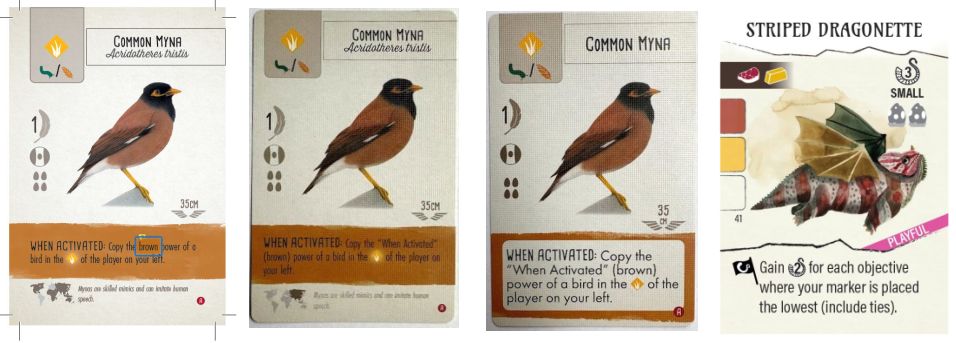
Creating accessible games requires designers, developers, and publishers to identify the presence of unintentional barriers and seek innovative solutions. In this article I share Stonemaier Games’ efforts to reduce challenges for colorblind and low-vision players, including my role as a freelance proofreader and accessibility reviewer.1
Wingspan

Wingspan was one of my first Colorblind Games written reviews, and it stemmed from designer Elizabeth Hargrave answering my question about color vision accessibility considerations during the game’s design and development:
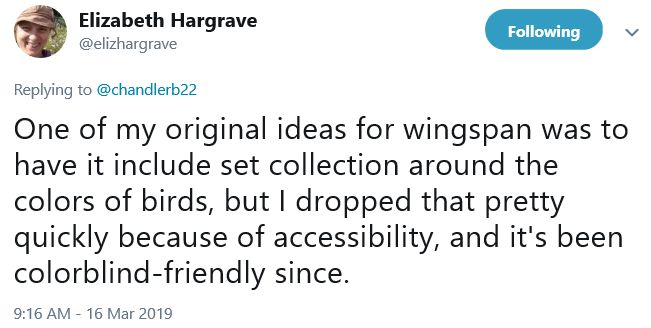
I have been able to play Wingspan with minimal color vision barriers, but I did experience one issue from time to time. As shown below with the Northern Mockingbird, some cards refer to powers only by their color (e.g., brown, teal, and pink). That same area includes relatively small/thin font and less-than-ideal contrast between the black text and colored backgrounds.

Wingspan Asia

Wingspan Asia is the third expansion following Europe and Oceania. It includes continent-specific cards like the others, serves as a 2-player stand-alone game, and provides additional rules for up to 7 players. I was hired as a freelance proofreader for all components in the game; Jamey Stegmaier also asked me to identify accessibility needs and recommend solutions to support colorblind and low-vision players.
Wingspan Asia’s draft rules and cards included the same issue I mentioned above: powers identified only by their color, like this tip from page 5 of the draft rulebook.

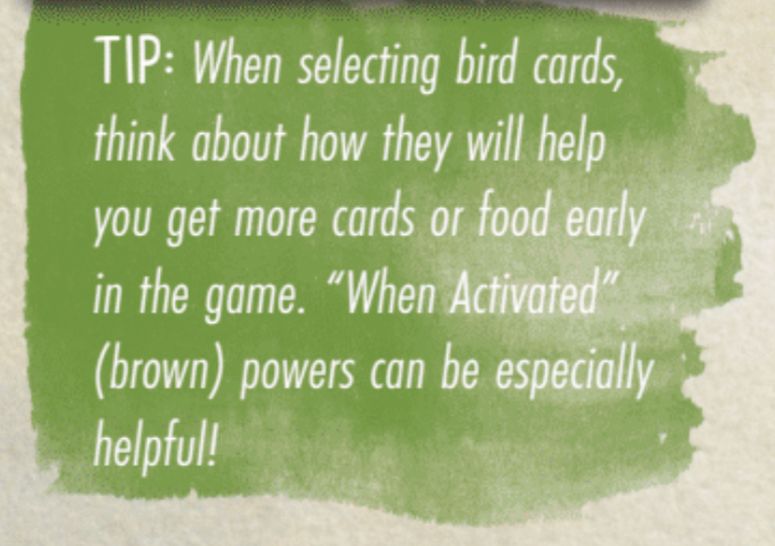
The final version of the rulebook double-codes that tip, providing both the name of the power, When Activated, and that power’s color (brown). Another example is the Common Myna card. The draft layout includes a reference to the brown power, so I recommended a change. As shown below, the final published version includes the name of the power (When Activated) and its color (brown).
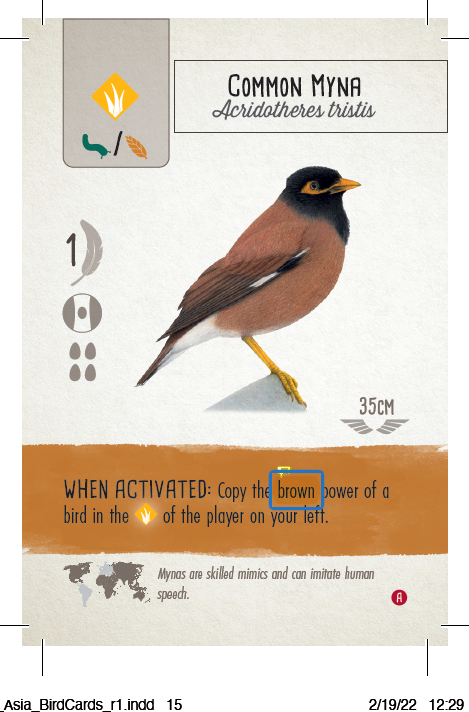
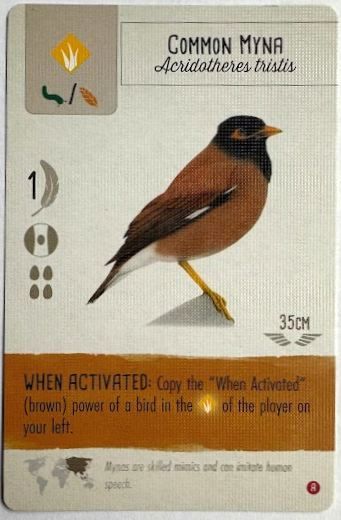
Wingspan Vision-Friendly Cards
In 2022, Jamey and the team looked to address visual accessibility issues, and he asked me what changes might be most appropriate to make the cards easier to read.
“I wanted to let you know that we’re planning to create and release a set of Wingspan bird cards designed for vision impairment and low lighting. The solution I’m aiming for is to change all of the icons on the left from brown to black, to remove the flavor text, and expand the mechanical text box so we can increase the text size from 10pt to 12pt if possible.
Does that cover everything we need to do? People often mention the ‘small font and contrast’, but they’re not specific about it, so I can never really tell if they’re talking about the flavor text, text on a certain power type (different background colors), etc. I’d appreciate your feedback.”
Jamey Stegmaier, April 2022
A prototype version of the vision-friendly cards looked like this.

I recommended a few items for the team to consider:
- Improve Contrast. For the black-on-brown WHEN ACTIVATED text and the black-on-teal ROUND END text, make the text more readable by further changing the background.
- Clarify Wingspan Measurement. Increase the font size of the number, make it black, and either separate the “CM” from the number or reduce its font size for clarity.
- Find More Space. Consider reducing the bird art size to make room for larger text.
Final Vision-Friendly Cards. After some additional tweaks, Stonemaier’s graphic designers removed the remaining non-gameplay elements (i.e., the world map and Latin bird name) and increased contrast even more for the Power text. The final changes are significant, and these alternate versions are now my standard cards for Wingspan gameplay. Use the slider below to see an example of these changes.


Selling Accessibility. Stonemaier Games experienced disappointing sales of this add-on during its first month available, which led to a blog post on their website: If You Want It, We’ll Make It…but Will You Buy It? In it, Jamey shared that there seemed to be a vocal demand for vision-friendly cards, but when the product was made available, no one purchased it.
“We produced a small print run of the cards (2500 units per set) and announced them in our newsletter, Facebook, Instagram, YouTube, and on this blog. They’ve been on our webstore for the last month.
But no one bought them.
Okay, that’s a slight exaggeration. 175 people bought them. I very much appreciate those customers, but this is easily our worst-ever product launch.”
Stonemaier Games Blog, June 2023
Accessibility Tax. Jamey’s blog post included some ideas about why the product didn’t sell, including price point, consumer interest, or whether people knew it existed. My own guess is that this is an example of the “accessibility tax” that requires gamers with accessibility needs to pay extra to overcome our barriers. For example, the vision-friendly cards are not the new Wingspan standard; they will not be used in future printings, and they cannot be selected as an option when purchasing the game. Instead, these are separate products that consumers must purchase in addition to the standard game.
So while the vision-friendly cards are a step in the right direction, an add-on is not a complete solution for accessibility.
Wyrmspan

When I was asked to serve as a proofreader for Wyrmspan (designed by Connie Volgemann), I was delighted to see how much of the accessibility improvements from Wingspan’s expansions and vision-friendly cards were included in the new game!
- Font Size. Fonts are large: both the dragon name and the mechanism text at the bottom are similar to the vision-friendly cards.
- No Flavor Text on Cards. Flavor text is no longer on the cards, but instead is provided in a 32-page dragon fact book. Besides the illustration, all other graphic elements are required for gameplay.
- Dragon Sizes. Wingspan measurements were replaced by a simpler relative size value in large font.
- Double-coded Attributes. The dragon’s attribute (‘shy’ in the example below) is provided in both text and color.
- Positional Double-coding. The three cave indicators on the left side are double-coded by position: top, middle, and bottom.
![Wyrmspan card Tawny Northern Drake includes painting of the dragon, graphic design elements for gameplay, and the text, "Gain [2 victory points] for each marker you have placed on the Dragon Guild."](https://colorblindgames856116223.files.wordpress.com/2024/01/image-9.png?w=510)
The Journey Continues
Since the 2019 release of Wingspan, Stonemaier Games has made continuous improvements toward visual accessibility. The publisher is not perfect with regard to accessible gaming, and I play a part of that ongoing imperfection. But these changes – made in only 5 years with just one publisher – make me optimistic about a future that includes more people playing more games!
1 Disclaimer: I have worked as a paid freelance proofreader on Wingspan Asia, Wingspan Vision-friendly Cards, and Wyrmspan, among other Stonemaier Games titles (see the full list here).
All images and e-mail correspondence are used with permission from Stonemaier Games.



Wow, I absolutely loved your blog post! It’s so inspiring to see the progress made in accessibility. From Wingspan to Wyrmspan, your insights and experiences have given me hope for a more inclusive future. Keep up the amazing work!
Here is my gaming blog url is http://www.gta5modded.com
LikeLike
An interesting read about a topic that I have a vested interest in. 😉
“So while the vision-friendly cards are a step in the right direction, an add-on is not a complete solution for accessibility.”
Apologies for isolating this one quote for push back. I realise that the overall arc – industry wide and within Stonemaier Games – appears to be going in the right direction but I think you’re being over generous here. I don’t think that purchasable add-on vision-friendly cards are in any way a solution to the problem of poor accessibility in board games. They simply highlight its continued presence.
As you say,
“[T]he vision-friendly cards are not the new Wingspan standard; they will not be used in future printings, and they cannot be selected as an option when purchasing the game.”
The purchasable add-on is effectively a second barrier to accessibility. The first being the inaccessible, potentially unplayable, base game.
If Stonemaier Games want to be perceived as genuine champions of accessibility they need to design it in, not outsource it to an aftermarket expansion.
LikeLike
Thanks for reading and great comment. I agree that a purchase-able item is not a solution, per se, but I’m coming from a previous world where there are no vision-friendly cards produced by the publisher at all. Having worked in accessibility here in games and my day job (traffic engineering), see ANYTHING related to colorblind and low-vision needs is a win in my book, but not the end of the story.
LikeLike
I appreciate the work that went towards improving accessibility (not particularly needing it myself), this is definitely something that should be a part of the initial design and not an afterthought. I am happy to see that this is happening more often lately.
Also, I wonder if some of this work sometimes does not survive translations to other languages, I have not checked if the color references in my translated version of Wingspan, but the translated version of the European and Oceania expansions uses slightly thinner fonts than the base game and Asia, and this is definitely harder to read. Is there perhaps a set of guidelines for translations that points out these accessibility requirements that is given to the studios that translate games? There are also differences in bird name casing (hard to notice due to it using small caps) and whatnot, but that does not really affect accessibility, it is just inconsistent.
Finally, this mentions the lack of flavor text on cards as being a good thing (in order to add extra space, which is an understandable tradeoff). However, the flavor text in Wingspan is one of my favorite features, and I would definitely be sad if it was gone in the next expansion. It is a great thing to look at while waiting for others to play and teaches some new interesting tidbits, and it has lead to a whole bunch of fun moments during playing. If this was in a separate book, it would just not get read. Of course, this relies on the flavor text actually being interesting, and I would understand if the text in Wyrmspan (I have not played the game yet) was not quite as worth keeping as it talks about fictional dragons rather than real species.
LikeLike
Great comments, and thank you for sharing your experience of the flavor text. Given its small size in most games, I rarely read any non-gameplay text on cards, so I’m definitely influenced by that.
I have definitely heard a lot of people preferring the flavor text in Wingspan to the lack of it in Wyrmspan. Ideally there would be both options (for Wingspan this is true now with the Vision-friendly cards) for many games.
LikeLike